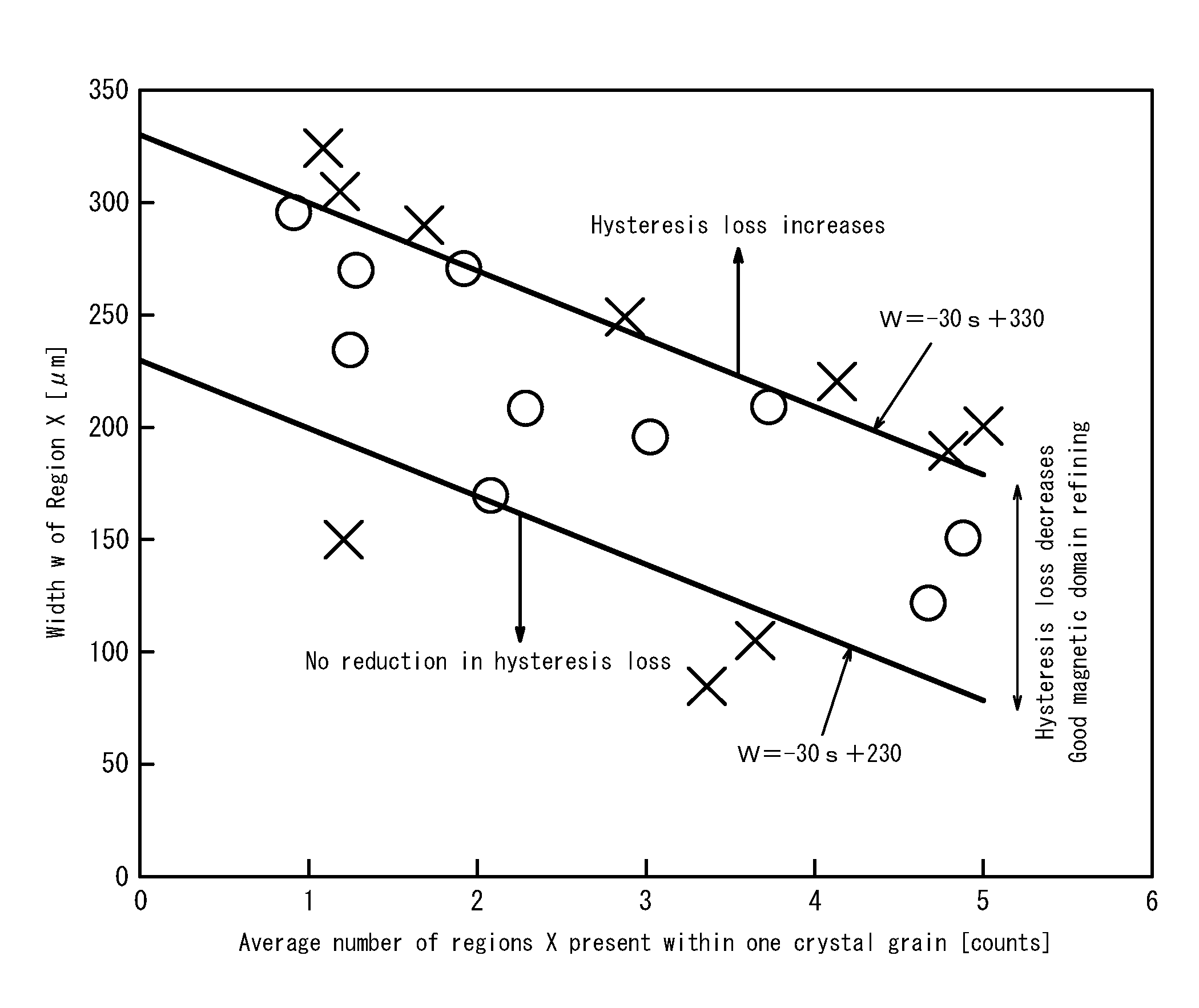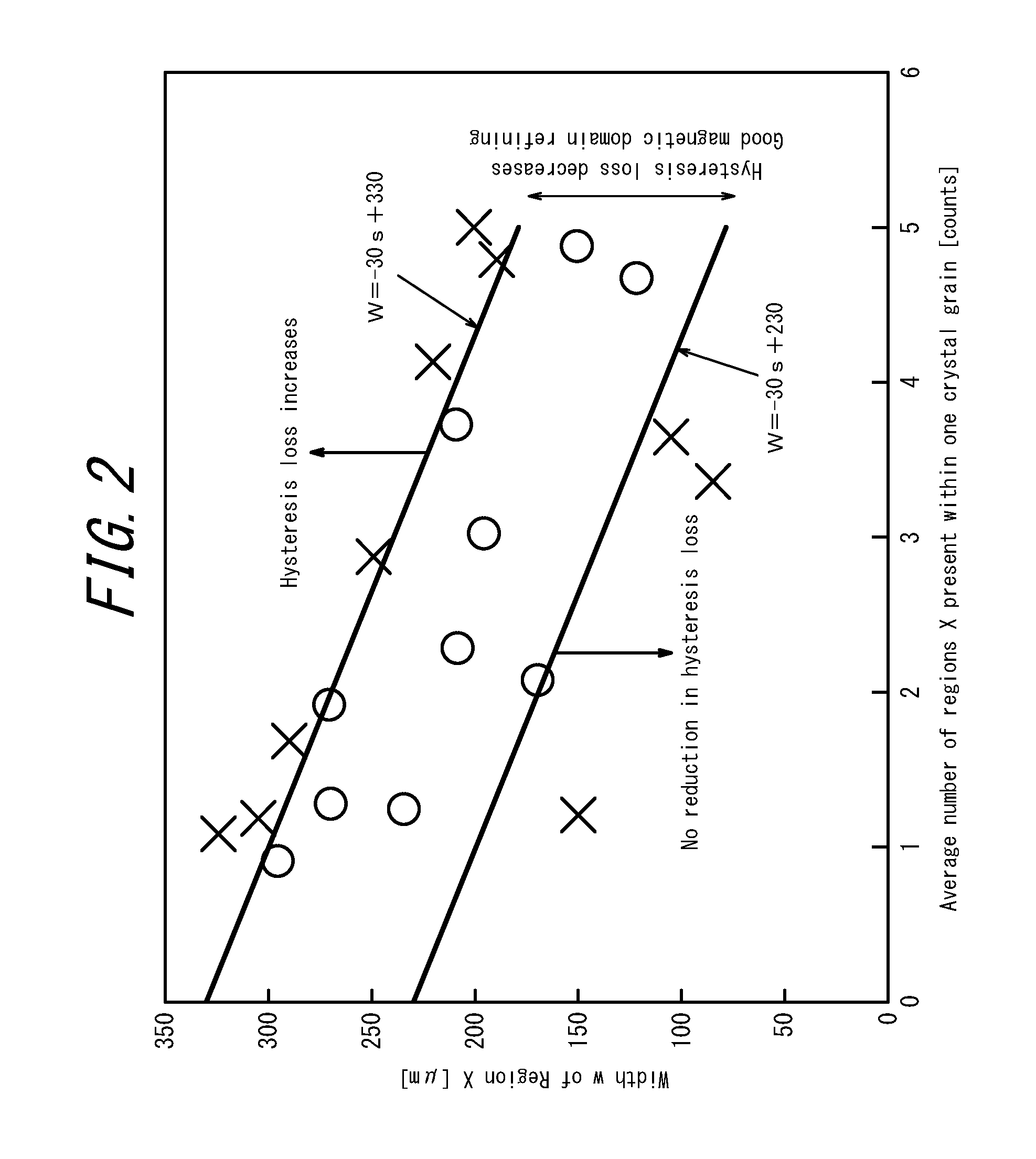Grain-oriented electrical steel sheet and method for producing same
a technology of electrical steel and grain-oriented sheets, which is applied in the direction of magnetism of inorganic materials, magnetic materials, magnetic bodies, etc., can solve the problems of increasing eddy current loss, reducing magnetic energy, and limiting the amount of tension that can be applied to the steel sheet, so as to reduce eddy current loss and reduce hysteresis loss , the effect of low hysteresis loss
- Summary
- Abstract
- Description
- Claims
- Application Information
AI Technical Summary
Benefits of technology
Problems solved by technology
Method used
Image
Examples
example 1
[0063]The material used in this experiment were grain-oriented electrical steel sheets, each having a measured sheet thickness of 0.22 mm and a flux density B8 in the rolling direction of 1.85 T to 1.95 T, and having a dual-layer coating on its surfaces, including a vitreous coating, which is mainly composed of Mg2SiO4, and a coating (a phosphate-based coating), which is formed by baking an inorganic treatment solution thereon.
[0064]Electron beam irradiation and laser irradiation were used to apply closure domain regions X. In each irradiation run, an electron beam and a laser beam were scanned linearly over the entire sheet width so that the electron beam irradiation portions and the laser irradiation portions extend across the steel sheet in the transverse direction (a direction orthogonal to the rolling direction) of the steel sheet.
[0065]For electron beam irradiation, the irradiation was repeated along the scanning line so that a long irradiation time (s1) and a short irradiatio...
example 2
[0075]Electron beam irradiation was performed under the same conditions as described in Example 1, except that grain oriented electrical steel sheets having measured sheet thicknesses of 0.18 mm, 0.19 mm, and 0.24 mm were used.
[0076]The measurement results thereof are shown in Table 2.
TABLE 2Improve-Improve-mentmentImprove-Hys-inin Eddyment inSheetteresisHysteresisCurrentCoersiveCoersiveThick-ConditionalLossLossLossForceForceResion XnessCoatingwsExpressionWh17 / 50ΔWh17 / 50ΔWe17 / 50HcΔHcNo.Applied by(mm)Tension*(μm)(counts)Applicability(W / kg)(W / kg)(W / kg)(A / m)(A / m)Remarks23Electron Beam0.18A2802.5Applicable0.3040.0180.2076.020.77InventiveExample24Electron Beam0.18A2105.0Applicable0.2950.0100.2226.210.61InventiveExample25Electron Beam0.19A3455.0Not Applicable0.2980.0020.2636.120.32ComparativeExample26Electron Beam0.19A2601.3Applicable0.2800.0120.1365.590.66InventiveExample27Electron Beam0.19A2602.5Applicable0.2860.0130.2015.890.39InventiveExample28Electron Beam0.19A2204.0Applicable0.2840....
example 3
[0078]Further, 100-mm wide steel sheets subjected to magnetic domain refining were used to produce model transformers, each being 500 mm square and simulating a transformer with an iron core of stacked three-phase tripod type, and the model transformers thus obtained were subjected to noise measurements.
[0079]The model transformers were formed from a stack of steel sheets that were sheared to have beveled edges, with a stack thickness of about 15 mm and an iron core weight of about 20 kg. The transformers were excited with the three phases being 120 degrees out of phase with one another, where noise was measured under excitation at 1.7 T, 50 Hz. A microphone was used to measure noise at (two) positions 20 cm away from the iron core surface, in which noise levels were represented in units of dBA with A-scale frequency weighting (JIS C 1509).
[0080]Table 3 shows the measurement results.
TABLE 3Steel SheetTransformer Noise (dBA)No.Before IrradiationAfter IrradiationRemarks133638Comparati...
PUM
| Property | Measurement | Unit |
|---|---|---|
| Magnetic domain | aaaaa | aaaaa |
| Thickness | aaaaa | aaaaa |
| Force | aaaaa | aaaaa |
Abstract
Description
Claims
Application Information
 Login to View More
Login to View More - R&D
- Intellectual Property
- Life Sciences
- Materials
- Tech Scout
- Unparalleled Data Quality
- Higher Quality Content
- 60% Fewer Hallucinations
Browse by: Latest US Patents, China's latest patents, Technical Efficacy Thesaurus, Application Domain, Technology Topic, Popular Technical Reports.
© 2025 PatSnap. All rights reserved.Legal|Privacy policy|Modern Slavery Act Transparency Statement|Sitemap|About US| Contact US: help@patsnap.com



